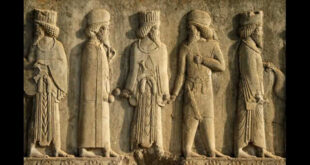Kirkuk (ancient: Arrapha)
At Ta’min Governorate. In Iraqi Kurdistan, near the Khasa River, 250 km north of Baghdad.
The modern city and also the site of the ancient Hurrian and Assyrian capital of Arrapha, strategically located, of great importance to the Assyrians.
Dates: Assyrian period, late 3rd and 2nd millenium BC;
flourished again under the Mamluks, 1250–1360 AD
The archaeological sites of Qal’at Jarmo and Yorgan Tepe are found at the outskirts of the modern city.
 |
 |
 |
 |
 |
 |
The city was from ancient times a very historically and ethnically mixed center (Hurrians, Mitannians. Arameans) as it is today, with Kurds, Arabs Turkmen and Assyrians (Chaldean Christians). The ancient city was founded 5000 years ago by Hurrian tribes, sometimes identified with the Guti by the southern Mesopotamians, and mentioned in cuneiform texts from around 2400 BC as the capital of Gutium. The city later recognized the rule of Ishbi-Erra of Isin (circa 2000).
As the capital of a small Hurrian kingdom of the same name, Arrapha was strategically situated on the southeastern edge of the much larger kingdom of Mitanni, with a large Hurrian population, but ruled by an Indo-European (Aryan) aristocracy.
From about the 16th century to the mid 14th century BC, Arrapha and other small kingdoms in Assyria were vassals to Mitanni, but finally revolted, leading to the latter’s collapse in the 14th century. The city reached great prominence under the Assyrian empire. Around 900 BC, Adad Nirari II annexed Arrapha, which as an important garrison town, was always a key to Assyrian control of the hill country beyond the eastern border.
The Neo-Assyrian king Tiglath-Pileser III (circa 740 BC) resettled Aramean tribes there and made Arrapha a province, a long narrow territory now running down the eastern side of the Tigris, the key to Assyrian control of Babylonia.(because they could avoid the easily defensible area at the neck formed by the convergence of the Tigris and Euphrates. ) Later, as the Assyrians were making their last stand (along with their erstwhile enemy, the Egyptians) against the Babylonians and their Median allies, they tried to secure Arrapha, but were pushed out, and the Medes later attacked the province. The ancient city of Arrapha has never been excavated.
Kirkuk’s much-revered medieval center, surrounding Daniel’s Mosque, the Citadel and the Green Dome Mosque, was destroyed by the Saddam regime in 1997-98 “beautification” program, part of the ethnic cleansing of Kurdistan. Only Daniel’s Mosque, the Citadel and the Green Dome Mosque remain, surrounded by barren ground.
The Kirkuk Citadel stands on an artificial mound 130 feet high located on a plateau across the Khasa River. The mound, or tell, is believed to have been built by King Ashurnasirpal II between 884 and 858 BC as a military defence line of Arrapha. Under King Sluks, the citadel was encircled by a rampart with 72 towers. A jewel of the citadel is the so-called “Red Church,” which has traces of pre-Muslim mosaics.
The two principal religious sites in Kirkuk are: the Green Dome Mosque, completed in 1362 AD, has interior of 830 square meters and a 17-meter-high dome; and Daniel’s Mosque with its twin 13th century domes and four tombs of Jewish sons (Hanen , Ezra , Michele and the prophet Daniel) (two hypotheses concerning the Tomb of Daniel exist, one putting the tomb in Babylon at present-day Kirkuk and the other putting the tomb at Susa).
 History of Kurdistan
History of Kurdistan



